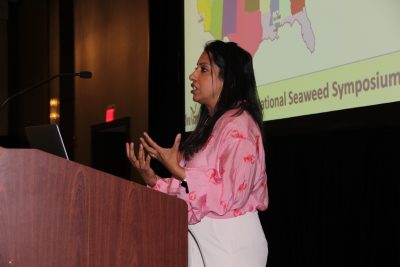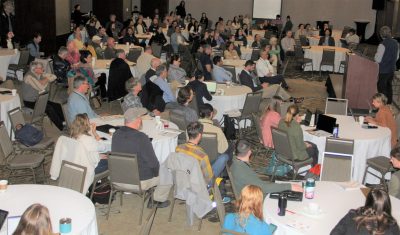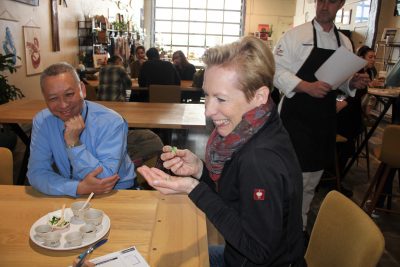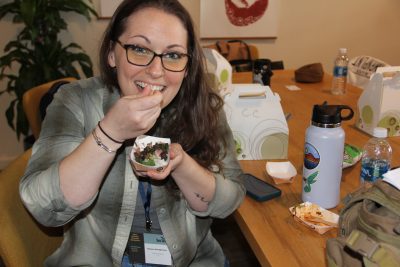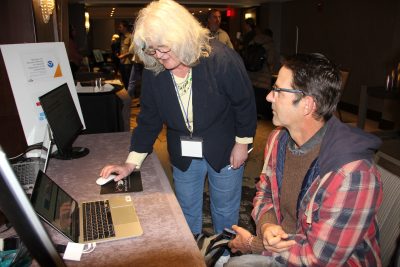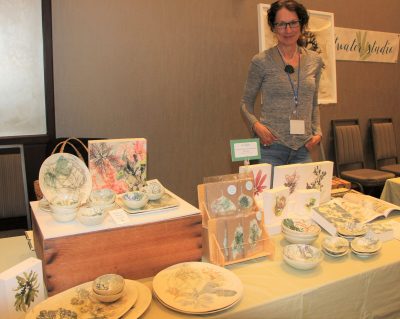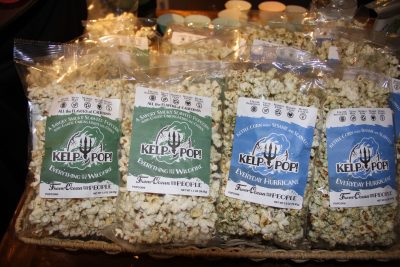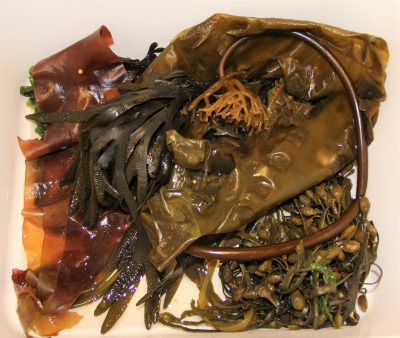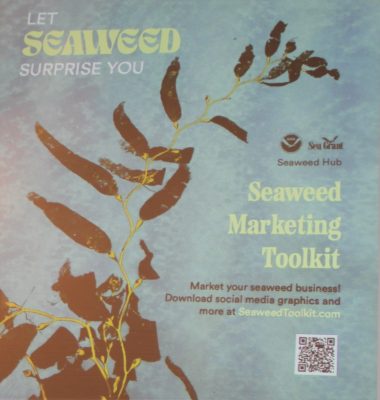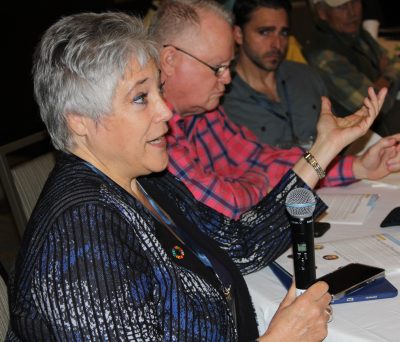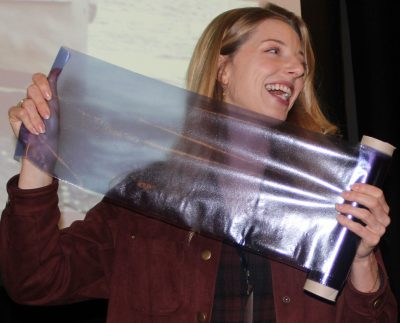
Story and photos by Judy Benson
Seaweed, said Keolani Booth, isn’t exotic or strange to the native Alaskan community that is his home.
“I’ve been harvesting seaweed my whole life,” he said, as a photo of him and his daughter harvesting from a canoe was projected on the screen behind him. “It’s a highly sought-after food, that has a rich and complex taste and medicinal properties. We’ve long traded it with inland tribes for game. Harvest time is a very happy time for us. It’s really about community, and I hope you consider that communities can really go with this effort.”
Booth is a tribal councilman in the Metlakatla Indian Community on the Annette Islands. He made his remarks during his keynote address at the 2023 National Seaweed Symposium in Portland, Maine, setting the stage for the three-day event last month of robust and varied presentations and networking to advance the young industry of domestic seaweed cultivation and use.
Hosted by the National Seaweed Hub and Maine Sea Grant, the symposium brought together growers, researchers, regulators, Sea Grant program staff and representatives of seaweed product companies from 20 states, Canada, Denmark and Mexico. Total attendance of 250 people reflected the strong growth in interest and progress since the establishment of the National Seaweed Hub in 2019, and the first symposium in 2020, which drew 120 people. Work done by the hub, a collaboration of 10 Sea Grant programs, and in work groups formed at the first symposium to identify and troubleshoot obstacles to the industry provided the framework for the topics addressed at the sequel symposium.
To start the 2023 symposium, Anoushka Concepcion, associate extension educator for Connecticut Sea Grant and lead of the National Seaweed Hub, outlined steps taken by one of the work groups, including creation of a seaweed nursery directory where growers can access seaweed seed for future crops. Other speakers summarized what other work groups had accomplished, along with statistics on the annual seaweed harvest in 10 coastal states, led by Maine and Alaska with 1 million pounds and 872,000 pounds respectively.
“We hope you have fun at the symposium. We hope you learn from one another and we hope you continue to engage with the Seaweed Hub,” Concepcion told the audience.
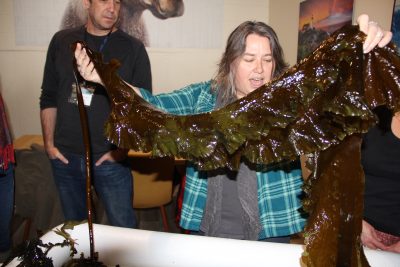
A second keynote address was given by Briana Warner, chief executive officer of Atlantic Sea Farms, a Maine company that produces seaweed veggie burgers, seaweed salad and other edible products. While there is great promise for applications of seaweed in many different products, from nutrition supplements to fertilizer to textiles, she cautioned against exaggerating its potential benefits as an environmentally friendly crop that can help mitigate climate change.
“Where fisheries are diminishing, seaweed aquaculture represents a sense of hope and independence,” she said. “It is not the answer, but it is an answer. It is a way people can do something to make the planet a little better. But think about the harm we can do to our own industry by overblowing the potential of seaweed.”
Presentations on the first day of the symposium covered a broad array of seaweed-related topics, from nuts-and-bolts issues such as food safety, permitting and processing considerations, to cutting-edge research on different seaweed strains and novel materials for seed string. During a panel discussion, Joth Davis of Blue Dot Sea Farms of Washington urged his fellow seaweed farmers to consider themselves as part of the larger community where their farms are located, avoiding conflicts whenever possible.
“You have to look at working with the community where you’re going to be farming,” he said. “It’s all about your community and walking in the footsteps of those people who you’re going to be impacting. If you ignore it, you ignore it at your peril.”
Robert Pomeroy, UConn professor emeritus and fisheries extension specialist at CT Sea Grant, turned the discussion to the economics of seaweed farming with a presentation of a business planning tool for growing kelp, the most common seaweed type raised through aquaculture. The computer-based tool, which he has been developing over the past three years with Tammy Warner, professor of management at Keene State University, is near completion. During a Seaweed Showcase event the next day, he and Warner demonstrated the tool in one-on-one meetings with prospective farmers.
“We’ll be doing a lot of training on this with our Sea Grant partners to show them how to use it,” Pomeroy said. “We’ve developed it to be very user friendly.”
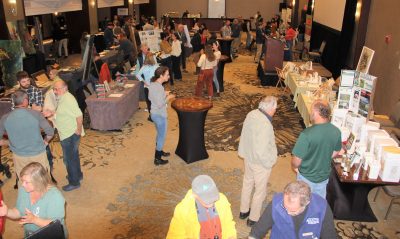
The showcase, which featured numerous vendors of seaweed products – from animal feed to artwork to cosmetics and granola bars – came at the end of a day of field trips to local seaweed farms, a culinary demonstration featuring seaweed, and Portland’s working waterfront.
Highlighting the third day of the conference were talks about what the future might hold for the seaweed industry. Jessica Chalmers, co-founder of Everything Seaweed, talked about her company’s plans to build a bioengineering facility to turn seaweed into biodegradable microfiber textiles. Ocean’s Balance Chief Executive Officer Mitch Lench said his firm is investing in a “gargantuan” dehydrator for kelp that he envisions will be used by many independent seaweed harvesters.
“It’s been the big bottleneck in the industry,” he said, referring to the lack of processing facilities for seaweed. “This equipment will be able to dry 30,000 pounds per day.”
A third entrepreneur, Julia Marsh of the California-based company Sway, held up sheets of transparent film made of seaweed, one of the compostable plastic alternative products her company manufactures.
A major announcement came from Jaclyn Robidoux, marine extension associate at Maine Sea Grant and lead organizer of the symposium, of the “Let Seaweed Surprise You” marketing campaign, which grew out of the marketing opportunities work group formed at the first symposium. She showed logos and a marketing tool kit that will be used in the campaign to familiarize the public with seaweed and its uses.
The symposium ended with an international perspective on the seaweed industry, with speakers from Mexico and Denmark along with Nichola Dyer, senior advisor of the Global Seaweed Coalition. It has 1,000 members worldwide and has a mission “to support the safety and sustainability of the seaweed industry,” according to its website. The coalition is currently sponsoring 24 projects around the world, researching heavy metal content, nutritional value, safe post-harvest practices and other topics.
“We don’t want to hype,” Dyer said. “We want to make sure the message is one of enthusiasm and optimism and is grounded in science.”
Judy Benson is the communications coordinator of Connecticut Sea Grant.
